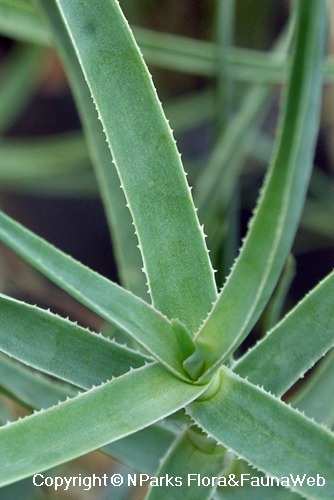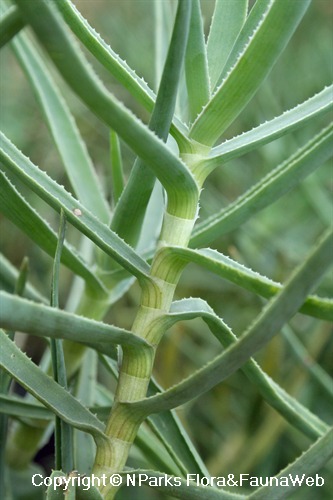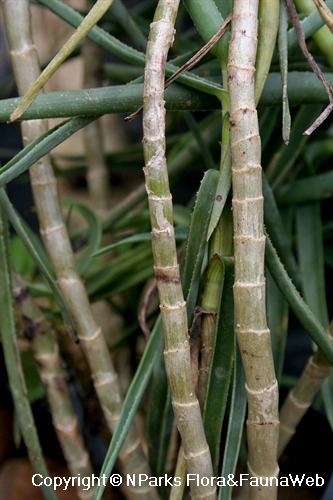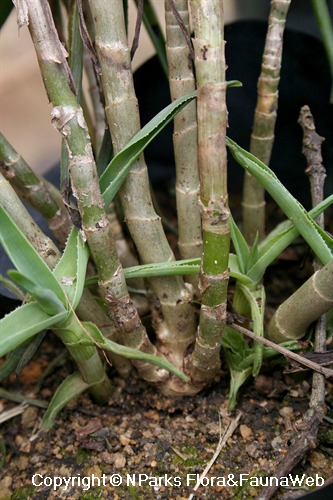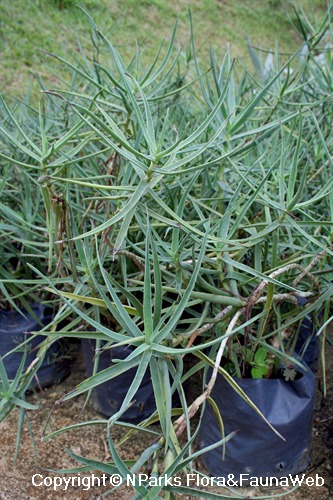
Back
Aloiampelos tenuior (Haw.) Klopper & Gideon F.Sm.
| Family Name: | Asphodelaceae |
| Synonyms: | Aloe tenuior var. decidua, Aloe tenuior var. viridifolia, Aloe tenuior var. densiflora, Aloe tenuior var. rubriflora, Aloe tenuior var. glaucescens, Aloe tenuior |
| Common Name: | iKhalana, Yellow Fence Aloe |
Name
Classifications and Characteristics
| Plant Division | Angiosperms (Flowering Seed Plants) (Monocotyledon) |
|---|---|
| Plant Growth Form | Climber, Herbaceous Plant |
| Lifespan (in Singapore) | Perennial |
| Mode of Nutrition | Autotrophic |
| Plant Shape | Shrubby |
| Maximum Height | 1.2 m to 3 m |
| Maximum Plant Spread / Crown Width | 0.6 m to 1.8 m |
Biogeography
| Native Distribution | South Africa |
|---|---|
| Native Habitat | Terrestrial (Grassland / Savannah/ Scrubland, Desert / Semi-Desert) |
| Preferred Climate Zone | Sub-Tropical / Monsoonal, Desert / Arid |
| CITES Protection | True (Appendix II) |
Description and Ethnobotany
| Growth Form | Herbaceous succulent shrub, with scrambling habit, up to 3m tall by 1.8m wide. |
|---|---|
| Foliage | Leaves fleshy, grey-green with powdery bloom. Narrowly lanceolate, sessile (stalkless), slightly cupped, curving upwards from stems and grouped into terminal rosettes. Tiny soft teeth found on leaf edges. |
| Stems | Green and faintly-striped when young; cane-like and greyish-green when mature, with distinctly-ringed appearance due to persistent leaf-node scars. Stems take root along nodes upon contact with the ground, up to 3m long, arising as suckers from rootstock that eventually becomes semi-woody near ground-level. |
| Flowers | Pale yellow to orangey-red, held in slender lantern-like nodding racemes, pollinated by nectar-gathering bees and other insects. Plant blooms from late autumn to early winter (May to August) in native range. Flowers not observed under local conditions. |
| Fruit | Small papery dehiscent capsules, with few seeds. |
| Habitat | Occurs in dry thickets from Eastern Cape to Southern KwaZulu-Natal in South Africa. |
| Similar | A member of a small group of shrubby scandent aloe lookalikes, which include: Aloe ciliaris (Climbing Aloe, plus 2 varieties), Aloe commixta, Aloe gracilis and Aloe striatula (Coral Aloe). |
| Taxonomy | Latest accepted Family (APGIII) is Xanthorrhoeaceae, formerly placed in Aloaceae and Asphodelaceae. Species was previously sub-divided into 3 subspecies, before being lumped into a single species. |
| Cultivation | Drought-tolerant, although regular watering promotes better-looking plants. Provide well-drained conditions to prevent stem rot. If grown near other plants and exposed structures, prune periodically to prevent latter from being scrambled over. May be attacked by scale insects. Easily-propagated by stem cuttings -- let cut ends dry over a few days, before placing in well-drained rooting media or into the ground at site. Seed propagation less convenient due to difficulty in seed collection. |
| Etymology | Genus epithet 'Aloe' derived from the Arabic ('Alloch') and Greek ('Aloe') names for plants from this genus, referring to the bitter juice obtained from the leaves. Species epithet 'tenuior' means 'thin' or 'slender', describing the plant's stringy stems. |
| Ethnobotanical Uses | Food (Herb or Spice) Others: Medicinal: Roots and leaves used as purgative and for expelling tapeworms. Culture: Bathwater made from the foam of leaves believed to be a powerful charm that brings good luck to the bather. |
Landscaping Features
| Desirable Plant Features | Ornamental Foliage, Ornamental Flowers |
|---|---|
| Landscape Uses | General, Suitable for Rooftops, Vertical Greenery / Green Wall |
| Thematic Landscaping | Silver Garden, Rockery / Desert Garden, Naturalistic Garden |
| Usage Hazard - Cons | Spines/Thorns - Leaf, Weak Branches |
| Usage Hazard - Cons Remarks | Tiny marginal spines on leaves |
Fauna, Pollination and Dispersal
| Pollination Method(s) | Biotic (Fauna) (Insects (Bee), Insects (Ant, Beetle, Fly, Thrip, Wasp)) |
|---|---|
| Seed or Spore Dispersal | Abiotic (Explosive Dehiscence) |
Plant Care and Propagation
| Light Preference | Full Sun |
|---|---|
| Water Preference | Little Water |
| Plant Growth Rate | Moderate |
| Rootzone Tolerance | Drought Tolerant, Well-Drained Soils, Poor Infertile Soils |
| Maintenance Requirements | Moderate |
| Propagation Method | Seed, Stem Cutting |
Foliar
| Foliage Retention | Evergreen |
|---|---|
| Mature Foliage Colour(s) | Green, Silver / Grey |
| Mature Foliage Texture(s) | Smooth, Leathery, Thick |
| Foliar Modification | Spine (axillary) |
| Foliar Type | Simple / Unifoliate |
| Foliar Arrangement Along Stem | Alternate |
| Foliar Shape(s) | Non-Palm Foliage (Lanceolate) |
| Foliar Venation | Parallel |
| Foliar Margin | Entire |
| Foliar Apex - Tip | Acuminate |
| Foliar Base | Truncate / Square |
| Typical Foliar Area | Microphyll ( 2.25cm2 - 20.25 cm2 ) |
Non - Foliar and Storage
| Stem Type & Modification | Herbaceous |
|---|---|
| Root Type | Underground (Fibrous Root) |
| Specialised Storage Organ(s) | Aboveground |
Floral (Angiosperm)
| Flower & Plant Sexuality | Bisexual Flowers |
| Flower Colour(s) | Yellow / Golden |
|---|---|
| Inflorescence Type | Raceme |
| Flowering Period | Rarely |
| Flowering Habit | Polycarpic |
Fruit, Seed and Spore
| Fruit Classification | Simple Fruit |
|---|---|
| Fruit Type | Dehiscent Dry Fruit , Capsule |
Image Repository
Others
| Master ID | 29448 |
|---|---|
| Species ID | 3757 |
| Flora Disclaimer | The information in this website has been compiled from reliable sources, such as reference works on medicinal plants. It is not a substitute for medical advice or treatment and NParks does not purport to provide any medical advice. Readers should always consult his/her physician before using or consuming a plant for medicinal purposes. |


